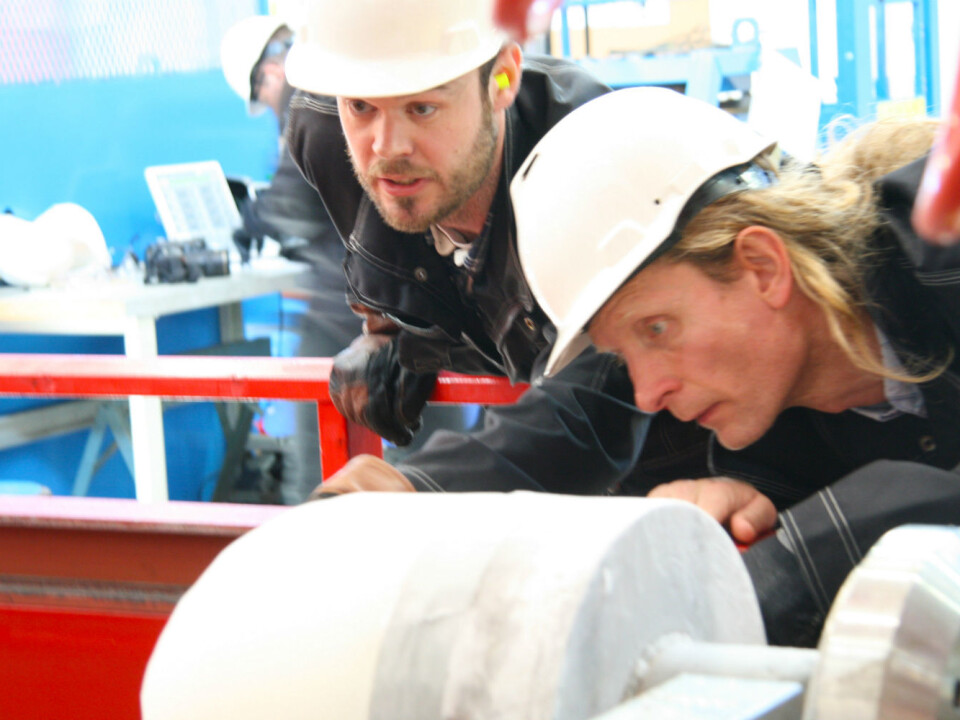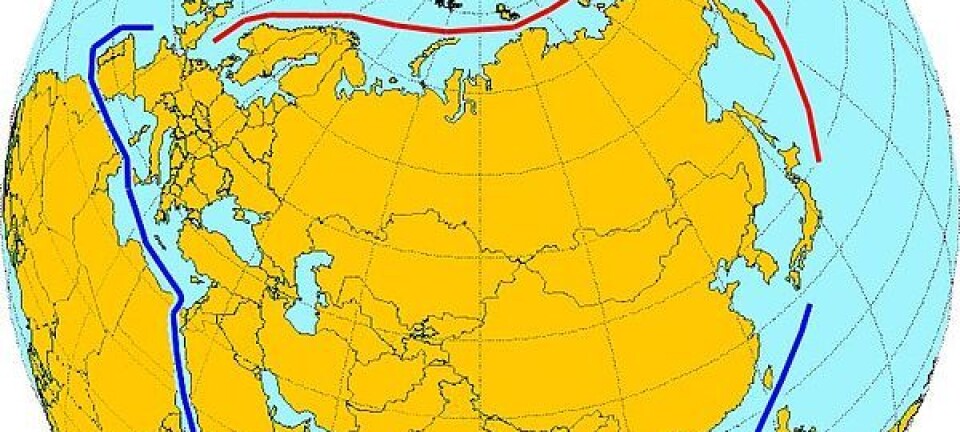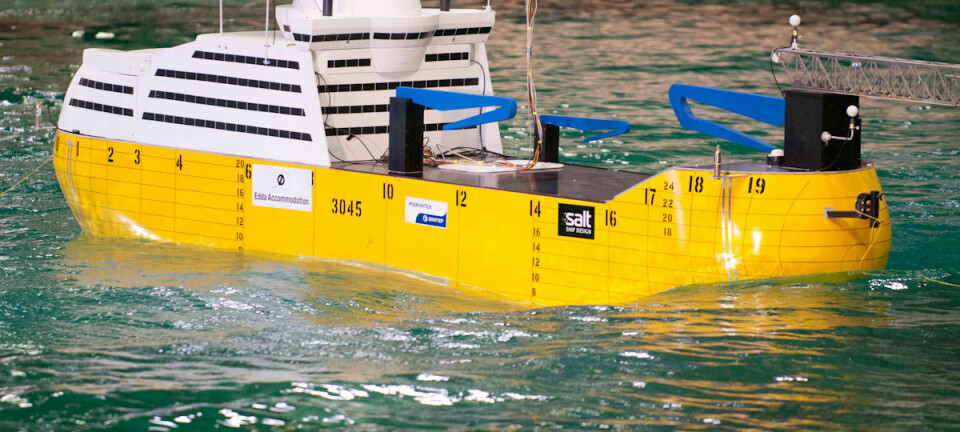An article from Norwegian SciTech News at NTNU

Celebrity ice
A colliding block of ice has caught the interest of Discovery Channel.
Denne artikkelen er over ti år gammel og kan inneholde utdatert informasjon.
They call it the Kicking Machine: a bright red, two-storey contraption with a swing arm that can deliver a blow so hard it has a 150,000 tonne concrete wall to absorb the shock.
Most days, when the Kicking Machine’s compressors are fired up to fuel its hydraulic punch, it is being used by researchers from SIMLab, NTNU’s structural engineering laboratory, to test how aluminium automobile bumpers will react in a high-speed crash.
In early June, Discovery Channel Canada came to NTNU to watch ice researchers use the giant machine.
But instead of crashing into a car bumper, the machine’s 700kg trolley was set up to drive a 50 kg bullet-shaped ice chunk into a steel beam to simulate what happens when an iceberg crashes into a ship.

The collisions are part of a series of tests that will give researchers the information they need to improve the design of ships that are increasingly finding their ways into Arctic waters.
Damage expected
“Ships are classified in different ice classes, which set the minimum strengths required for operation in certain conditions. But ships that could survive anything are too expensive to build,” said Martin Storheim, a SAMCoT PhD candidate whose research will use information from the tests.
“Ships are in fact expected to sustain damage from the ice. So our work will provide the knowledge needed to set a maximum damage level that is acceptable, and thus increase the safety.”
That’s exactly what drew Koula Bouloukos, a producer for Discovery Channel’s daily television programme Daily Planet, to the cavernous SIMLab testing facility to film for a day.

“It’s a perfect fit for us,” Bouloukos said of the decision to come to NTNU to make a programme about the ice research.
“Discovery Channel’s Daily Planet is all about science and technology and making things happen. But the deciding factor for us is that a lot of this research has the potential to save lives.”
Less ice, more traffic
The Finnish-Swedish explorer Adolf Erik Nordenskiöld was the first to journey from Europe to the Bering Sea across the top of the world in 1879, along what is now called the Northern Sea Route.
Nordenskiöld had to spend the winter frozen into the ice, which helped convince him and others that ship transit along the route was impractical.
But the draw is strong. A journey by ship through the Northern Sea Route has the potential to reduce typical transit times between Japan and Rotterdam by as much as 3,400 miles – ten days or more – compared to the traditional route via the Suez Canal.
Fast forward to 2013, when the Russian Federation reported that 71 ships made the Northern Sea Route journey, including the first-ever crossing by a container ship, the Chinese-owned Yong Sheng.
In 2010, just 4 ships made the same trip.
Some estimates predict that 5-15 percent of China’s shipping could travel via the Northern Sea Route by 2020.
Even with an ice-free Arctic in the summer, there could still be icebergs that could pose problems for the average ship, NTNU’s Storheim said.
“Ships will navigate around icebergs, which can be detected on radar,” he said.
“However, in waves, the radar won’t detect the smaller icebergs, which can have a mass of between 100 and 5,000 tonnes. Direct impacts with these undetected icebergs can be devastating for a normal ship at full speed.”
Made to resemble iceberg ice
The test involved three roughly 50-kg bullet-shaped chunks of ice, each frozen onto their own circular steel plate to be bolted to the Kicking Machine’s trolley. They were transported to the cavernous three-storey-tall building inside their own refrigerated 20-foot long shipping container, so they could be kept at a temperature of -25 degrees C.
“The ice was specially shaped to resemble glacial or iceberg ice,” said Ekaterina Kim, a SAMCoT postdoc who helped Storheim and his SAMCoT colleague Torodd Nord create the ice bullets.
The trio used a mix of commercially crushed ice and very cold fresh water, she said, after which the ice was milled into its bullet shape.
Transporting the ice from its chilly shipping container just 10 metres to where it could be bolted onto the Kicking Machine’s trolley proved to be one of the toughest parts of the test.
A two-second journey
As the Discovery Channel cameraman Mark Foerester follows along, Storheim and Nord muscle the unwieldy frozen bullet onto a handcart and wheel it over to the giant red Kicking Machine. From there it takes four people to bolt the structure onto the Kicking Machine’s trolley.
“The ice will start to melt now,” says Nord to Bouloukos.
After less than a minute, the ice bullet is attached. But the Kicking Machine’s hydraulic system needs to be charged, a process that takes 5 minutes, and one that can’t be done until everyone is clear of the powerful machine.
So everyone has to wait.
And then … “Three-two-one….” ,technical engineer Trond Auestad, counts down the seconds before the trolley hurtles towards the steel beam. Two seconds later, the ice bullet crashes into the steel beam with an enormous bang, and explodes into a thousand pieces.
Dented steel, crushed ice
One of the less well-understood problems that Storheim is studying is the interaction between a piece of ice and the side of a ship during a collision.
“When ice collides hard against the side of a ship, the ship side will deform. As it deforms, it will ‘embrace’ the ice, which in turn causes the ice strength to increase,” he said. “This can cause even greater damage to the ship, possibly causing flooding, an oil spill or even loss of the vessel. This coupled behaviour between the ice and the ship has to be accounted for in the design of a ship, but it has not been studied properly in the past.”
After the experiment is over, the researchers can look at both how the steel beam was deformed by impact of the ice, and how the ice itself was destroyed during the collision. To help them with this last task, the scientists have access to video from SIMLab’s two high-speed cameras, which can record the event at a rate of 18,000 frames per second. The video shows them exactly how the ice fractured and behaved during the test.
“This was quite successful,” Nord said after the last of three experiments was done.
“The results we get here, we can also publish. They are of a quality that will definitely strengthen our theories on ice structure interaction.”
External links
- Martin Storheim's profile
- Ekaterina Kim's profile
- Torodd Nord's profile
- Structural Impact Laboratory (SIMLab)
- Sustainable Arctic Marine and Coastal Technology programme (SAMCoT)


































